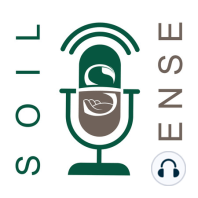37 min listen
Cover Crops Research and Strategy
FromSoil Sense
ratings:
Length:
29 minutes
Released:
Feb 9, 2021
Format:
Podcast episode
Description
We were able to capture some of the best information out there about soil health at the DIRT Workshop last December thanks to some fantastic speakers and some tremendous audience engagement.Today’s episode focuses on cover crops. You’ll hear from:
Dr. Hans Kandel, a South Dakota State University Professor and Extension Agronomist
Dr. Matt Ruark, a soil scientist from the University of Wisconsin at Madison
Dr. Dave Franzen, a professor and extension soil health specialist also at North Dakota State University
“There is not one cocktail or species that does best. It depends really on the wishes of the producer but there are many opportunities.” - Dr. Hans Kandel
Dr. Kandel prefers to think about using cover crops as a “mimicking of nature.” Multi-species growth is a natural occurrence in the prairie region so growing multiple species simultaneously is naturally supported by the ecosystem. He explains that different cover crops are better suited for different outcomes. If you are looking for something to be sustained throughout the winter then a winter hardy crop like winter rye, winter wheat or camelina may be the best fit. For added nitrogen, peas may work best. Another consideration may be susceptibility to potential disease transfer. Mixes of species have the potential of achieving multiple goals but they also add the concern that you may be watering down some specific benefits by adding more plants that will compete for the same resources. Ultimately the main priority for the producer helps inform the best cover crop and the best timing and method for seeding.
“What gets me the most excited about evaluating cover crops is trying to get the use of legumes in rotation because it does have that short term economic benefit of supplying some nitrogen.” - Dr. Matt Ruark
Dr. Ruark focused his discussion on the benefits of biomass with legumes and how to best manage their growth. “That’s the trick with legumes….for me the legumes are strictly a biomass game….The more biomass you have the more nitrogen release you have.” Of course sometimes that biomass can be overwhelming. Dr. Ruark suggests that you can either use excess biomass as a forage source, you can terminate early to reduce the amount of biomass produced or you can adjust your nitrogen fertilizer application. He does highlight that we are still at the “mercy of the weather patterns, especially in the spring” for growth of cover crops after harvest so control is never absolute.
“I think just being aware and knowing that you’ve got to manage the thing instead of just let it grow until you plant. You have to keep your eyes open and use some common sense when you have cover crops in the west.” - Dr. Dave Franzen
Connect with Soil Sense:
Soil Sense Initiative
Soil Sense Podcast is hosted by Tim Hammerich of the Future of Agriculture Podcast.
Dr. Hans Kandel, a South Dakota State University Professor and Extension Agronomist
Dr. Matt Ruark, a soil scientist from the University of Wisconsin at Madison
Dr. Dave Franzen, a professor and extension soil health specialist also at North Dakota State University
“There is not one cocktail or species that does best. It depends really on the wishes of the producer but there are many opportunities.” - Dr. Hans Kandel
Dr. Kandel prefers to think about using cover crops as a “mimicking of nature.” Multi-species growth is a natural occurrence in the prairie region so growing multiple species simultaneously is naturally supported by the ecosystem. He explains that different cover crops are better suited for different outcomes. If you are looking for something to be sustained throughout the winter then a winter hardy crop like winter rye, winter wheat or camelina may be the best fit. For added nitrogen, peas may work best. Another consideration may be susceptibility to potential disease transfer. Mixes of species have the potential of achieving multiple goals but they also add the concern that you may be watering down some specific benefits by adding more plants that will compete for the same resources. Ultimately the main priority for the producer helps inform the best cover crop and the best timing and method for seeding.
“What gets me the most excited about evaluating cover crops is trying to get the use of legumes in rotation because it does have that short term economic benefit of supplying some nitrogen.” - Dr. Matt Ruark
Dr. Ruark focused his discussion on the benefits of biomass with legumes and how to best manage their growth. “That’s the trick with legumes….for me the legumes are strictly a biomass game….The more biomass you have the more nitrogen release you have.” Of course sometimes that biomass can be overwhelming. Dr. Ruark suggests that you can either use excess biomass as a forage source, you can terminate early to reduce the amount of biomass produced or you can adjust your nitrogen fertilizer application. He does highlight that we are still at the “mercy of the weather patterns, especially in the spring” for growth of cover crops after harvest so control is never absolute.
“I think just being aware and knowing that you’ve got to manage the thing instead of just let it grow until you plant. You have to keep your eyes open and use some common sense when you have cover crops in the west.” - Dr. Dave Franzen
Connect with Soil Sense:
Soil Sense Initiative
Soil Sense Podcast is hosted by Tim Hammerich of the Future of Agriculture Podcast.
Released:
Feb 9, 2021
Format:
Podcast episode
Titles in the series (100)
Intercropping and Soil Health by Soil Sense
